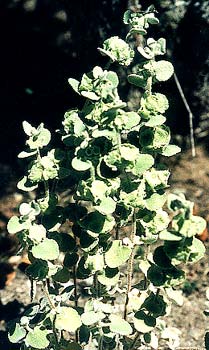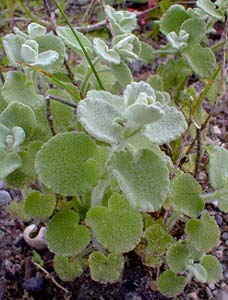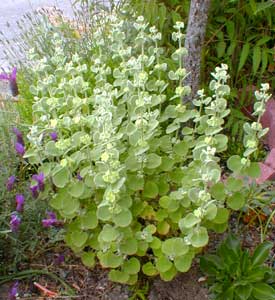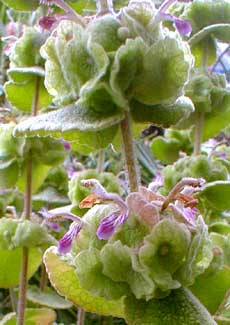
Dwarf Greek or Grecian Horehound,
aka, Dwarf False Dittiny,
aka, False Horehound
"Now, gentle Muses, your assistance grant,
While I this flower transplant
Into a garden stored with Poesy;
Where flowers & herbs unite, & haply some weeds be,
That, wanting not wild grace, are from all mischief free!"
-William Wordsworth
(1770-1850)
(1770-1850)
'Nana' is the dwarf form of the Greek Horehound Ballota pseudodictamnus, not to be confused with true horehound (B. vulgare aka Marrubium vulgare) from which a medicinal & confectionary syrup is derived.
The Grecian false horehound is a highly drought-tolerant plant, so was obtained for the roadside sungarden to set in the company of other heat-loving perennials. At the time of planting, it was just a tiny two-inch pot.
 It was an extremely hot summer that first year (2002), & even drought-hardy plants can be sensitive & need some attention when first getting started.
It was an extremely hot summer that first year (2002), & even drought-hardy plants can be sensitive & need some attention when first getting started.The False Dittany was too far beyond reach to get any attention at all. It did well for a while, & when the first July photo above was taken, I had no sense that anything could harm it. But during an unusual heat wave at the height of summer, the little plant appeared to have completely died. I seriously never expected to see it again.
But the following spring after a very long absence, it reappeared, & had put out enough of a root system for itself that it was a twice the size of the tiny start I originally planted. The second photo is of the brand new grey-green April (2003) foliage, furry & round as the ears of a cony. It was still only about eight inches tall, but should eventually grow to a foot height, which is half the size of the species.
 It was becoming so crowded by millfoils & hyssops that I finally dug up the little plant & moved it to another sun-garden. The third photo from May (2004) is in the new location.
It was becoming so crowded by millfoils & hyssops that I finally dug up the little plant & moved it to another sun-garden. The third photo from May (2004) is in the new location.For over two years in the old location its growth rate had been so slow that it never needed any pruning, but in the new spot, perhaps because the soil was better broken up & richer, it began spreading its clump width, & increased its height.
It is native to the Aegean Sea region, where it likes rocky areas. Though adaptable as to soil condition, limey poor soil is its favorite. Our soils are naturally acidic, so I have inserted amidst the horehound's roots a stick of chalkboard chalk to neutralize the acidity for this one plant without having to more broadly ammend the soil to the detriment of other plants.
 he rule of thumb for this kind of one-plant feeding of lime is to give it one piece of chalk for each ten inches of spread, once each spring. If you use this method for your sporadic alkaline-desiring plants around the garden, just make sure it is real chalk & not gypsum such as used in "blackboard crayons." Gypsum is calcium sulfate & has the exact opposite effect of the softer true chalk, which is calcium carbonate (lime). Real chalk is more powdery on the surface. You can test to be sure by putting a little piece of it in vinegar; real chalk will bubble.
he rule of thumb for this kind of one-plant feeding of lime is to give it one piece of chalk for each ten inches of spread, once each spring. If you use this method for your sporadic alkaline-desiring plants around the garden, just make sure it is real chalk & not gypsum such as used in "blackboard crayons." Gypsum is calcium sulfate & has the exact opposite effect of the softer true chalk, which is calcium carbonate (lime). Real chalk is more powdery on the surface. You can test to be sure by putting a little piece of it in vinegar; real chalk will bubble.If it likes its conditions it will spread into a one-foot or eighteen inch tall groundcover. In zones where temperatures get down to minus ten degrees F., it will die to ground in winter but return good as new in spring, whereas in warm climates it is thoroughly evergreen.
In our temperate zone it is an evergreen, experiencing very little winter damage, though some years when it does show much frost-injury, it can be hard pruned in spring, all the way down to the basal rosette, to make room for refreshed growth. If soil is too rich for it, it may get just a little leggy, or unattractive in the middle. If it does become unsightly after a while, it can be hard-pruned to start over.
The grey-green leaves are extremely pubescent, giving it a white & wooly appearance, each leaf the size & softness of a guinea pig's ears. Furriness is a common trait of dought-hardy plants. The slightest morning dew or faint misty rain adheres to the hairs of such plants as Horehound & Lamb's Ears, where balls of moisture can be seen until late into the morning, well after the dew has evaporated from the rest of the garden.
It can bloom from May through October, though in early summer mostly. The blossoms are unimposing, shown larger than life size in the fourth photo, snapped in July. Really it is for the foliage it is most prized, but there's a pleasant wee added interest when the small purple flowers are amidst the round furry leaves.
The stems of leaves with or without blossoms can be cut for bouquets, or dried for dry floral arrangements. The calyx of this furry plant has an unusual traditional use along the Aegean shores, in that it is floated on oil, then lit, serving as a wick.